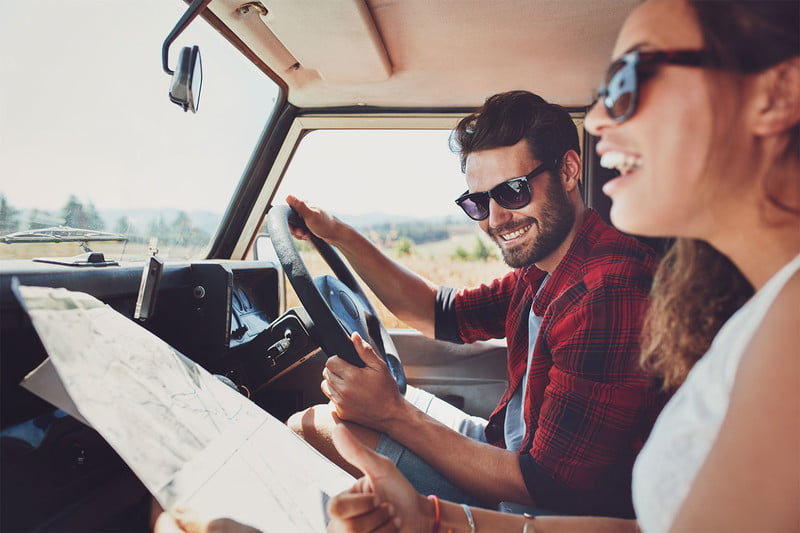Hitting the open road can make you feel free. No TSA lines, no baggage fees, no strict itineraries — just you, your car, and the endless possibilities ahead. But as romantic as it sounds, a great road trip doesn’t just happen. It takes planning, just enough to keep things smooth, but not so much that it kills the spontaneity. I’ve taken everything from weekend getaways to two-week-long cross-country marathons, and I’m ready to share what I’ve learned along the way to help you plan road trips that feel both organized and adventurous. So, here’s how to plan a road trip that you’ll never forget.
1. Start with the vibe, not the route

Before you even open Google Maps, ask yourself: What kind of trip do I want this to be?
Are you craving scenic beauty, like national parks and coastal drives? Or are you in it for quirky roadside attractions, small-town diners, and hidden gems? Maybe it’s about reconnecting with friends and family across state lines. Once you know the vibe you’re going for, you can start crafting a route that makes sense.
2. Use route planning tools, but don’t overschedule

Google Maps is a great starting point, but I also recommend apps like Roadtrippers, which lets you plug in your destinations and shows you interesting attractions, hotels, and eateries along the way.
Road trip expert Sabrina from Mom Van Up recommends driving no more than 450 miles or 8.5 hours on any day of a road trip. Any more than that, and you risk fatigue and missing out on cool stops. Personally, I try to cap daily drive time at 5 hours max. That gives you plenty of room for spontaneous detours or just stretching your legs at scenic overlooks.
3. Book lodging in advance, mostly

One of the best pieces of advice I ever got was this: Book your first night and your last night before you leave. It gives you a structure to the trip without locking you in too tightly. For everything in between, I usually book one to two days ahead, unless it’s peak season or a super popular spot like Yellowstone.
If you’re camping, make sure to check for permits and availability – many national parks require reservations months in advance.
4. Make a packing checklist, and don’t forget these road trip essentials

While packing depends on where you’re going and for how long, here are a few items I never hit the road without:
- Printed map or atlas (cell service can be spotty)
- Phone charger + battery pack
- Snacks (trust me, hanger on the road is real)
- Reusable water bottles
- Basic first-aid kit
- Car emergency kit (jumper cables, flashlight, etc.)
Also, when thinking about how to plan a road trip, make sure your car is ready. The National Highway Traffic Safety Administration recommends a pre-trip vehicle check: oil, tires, brakes, battery, and fluids. Or, do what I do and schedule a full-service check at your local mechanic the week before.
5. Build a flexible playlist and download podcasts

Music makes the miles go by faster. I usually create a few playlists with different vibes: upbeat for mornings, mellow for sunsets, and throwback hits for those moments when you just need to sing at the top of your lungs.
If you’re a podcast person, download them ahead of time in case of spotty service. Some favorites from my last trip included This American Life, Radiolab, and SmartLess. All perfect for long, open stretches of road.
6. Leave room for detours and spontaneous stops

This is the real magic of road tripping. Some of the best moments come from unplanned stops. Think: a roadside fruit stand in California, a tiny museum in the middle of New Mexico, or a bizarre but awesome dinosaur park outside of Rapid City, South Dakota.
7. Budget wisely (but leave wiggle room)

Gas prices fluctuate, so it’s a good idea to budget generously. Apps like GasBuddy can help you find the cheapest fill-ups along your route. I usually overestimate my daily fuel cost by 10-15 % just to be safe.
Also, budget for things like park entrance fees, meals out, and unexpected detours (like when you find out your motel is near a famous steakhouse that you have to try).
8. Know your limits

Road trip burnout is real. If you’re not used to being in the car for hours, it can sneak up on you. Build in buffer days or “zero-drive” days where you stay put and just explore. Trust me, your body will thank you.
9. Document your trip (but not just for social media)

I like to keep a little road trip journal. It’s not fancy, just a few notes every day about where we went, what we ate, or random things we noticed. Looking back at those pages years later brings back memories that photos alone can’t.
10. Expect the unexpected, and roll with it

When thinking about how to plan a road trip, expect flat tires, unexpected storms, strange detours — they’re all part of the adventure. Honestly, it’s the imperfect moments that usually turn into the best stories. I still remember a road trip to Las Vegas where I had to take the long way around, way off the beaten path, and genuinely thought I’d never get there. It wasn’t funny at the time, but now? It’s the part I laugh about the most.




